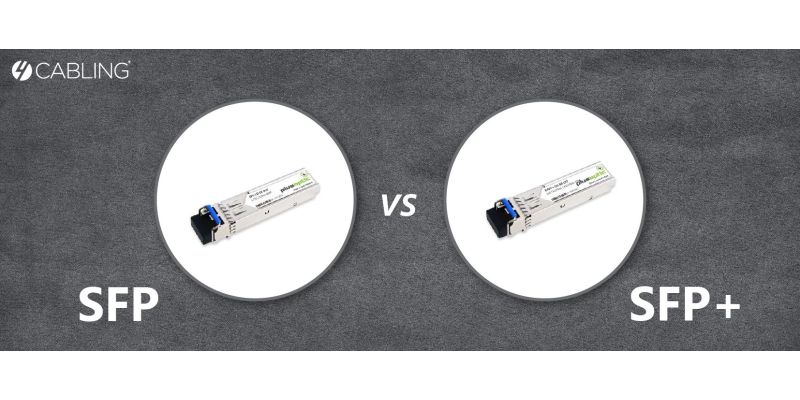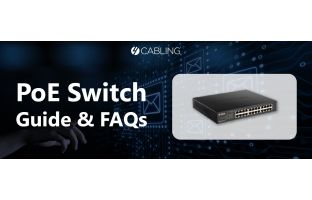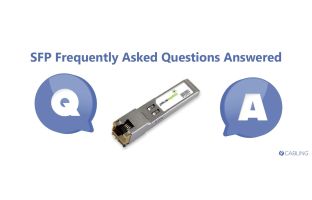SFP vs SFP+ Modules: Whats The Difference?
Connect your devices to switches, routers and network interface cards with SFP and SFP+ modules.
Both an SFP module and an SFP+ module are commonly used in telecommunication, data centres and enterprise networks. It is important to understand the key differences between SFP and SFP+ modules and what different types of SFP modules work best for your current set up to ensure the best network operation.
Read on to learn more about the key differences as well as connection capabilities.
What are SFP Modules?
SFP stands for small form-factor pluggable. Both SFP and SFP+ modules are type of hot-swappable transceivers that are used in networking set ups to connect devices such as switches routers and servers to a fiber-optic or copper network. They are compact in size and provide network administrators with flexibility to customise the network systems according to individual uses and needs.
Speed and Bandwidth:
One of the main differences between SFP and SFP+ modules is their speed and bandwidth capabilities. SFP modules are typically designed to support data rates of up to 1 Gbps, while SFP+ modules can support data rates of up to 10 Gbps. This means that SFP+ modules offer much higher bandwidth and faster speeds, making them ideal for high-speed applications such as data centers and enterprise networks.
Power Consumption:
It is also important to take into consideration the power consumption of SFP vs SFP+ modules when making the selection for your networking set up. For instance, SFP+ modules typically require more power than SFP modules due to their higher speeds and greater bandwidth. This means that SFP+ modules may not be as suitable for low-power devices or applications where power consumption is a concern.
Compatibility:
Additionally, when considering the compatibility of your devices and networking systems, SFP+ modules generally have an advantage over SFP modules. This is due to the fact that SFP+ modules are typically backward compatible with SFP slots, meaning that they can be used in devices that support SFP modules, however, the reverse is not always the case.
SFP modules may not be able to support the higher speeds and the increased bandwidths of SFP+ modules. Therefore, it is essential to consider the compatibility requirements of your network devices.
Cost:
As with any networking set up, cost is an important consideration. The pricing of SFP and SFP+ modules vary depending on the manufacturer, type of product, and individual specifications.
Generally, SFP+ modules are more expensive than SFP modules, mainly due to their higher speeds and greater bandwidth. However, it’s worth noting that the cost variation can be offset by the fact that SFP+ modules can often be used in devices that support both SFP and SFP+ modules, therefore providing greater flexibility and compatibility.
Applications:
It’s important to take into account the individual application of the SFP or SFP+ modules before you make a decision with your purchase. For instance, SFP modules are more suited to lower-speed applications where cost and power consumption are significant concerns. This commonly includes small office networks, at home set ups, branch offices, or other applications where 1Gbps speeds are sufficient for use.
On the other hand, SFP+ modules are better suited towards high-speed applications. These include networking systems where greater bandwidth and faster speeds are a necessity. SFP+ modules are commonly used in data centers, telecommunications networks or other enterprise applications where 10Gbps or higher speeds are required for use.
Common Frequently Asked Questions
Can you connect SFP to SFP+ modules?
Yes you can. An SFP+ module is an upgraded version of a standard SFP module that offers higher data rates and better performance. However, the physical connectors of SFP and SFP+ modules are the same, which means that you are able to connect them directly.
For example, you can connect an SFP module on one end and an SFP+ module on the other end using a compatible fiber optic cable. This flexibility ensures smooth connectivity and scalability for your networking setup.
Can I use multimode fiber with single mode SFP?
It’s important to consider the compatibility of the two. Generally, it is not recommended to directly connect single mode SFP modules to multimode fiber, mainly because multimode fiber has a larger core diameter. When connected directly with a single-mode SFP module, it could result in signal loss and reduced performance. You could use solutions available to bridge the gap, such as a mode conditioning cable or a media converter to connect single-mode SFPs with multimode fiber. However, it’s best to use the appropriate fibre type (multimode or single-mode) that matches your standard SFP module.
Are SPF+ modules interchangeable between different brands of networking equipment?
Yes you can. An SFP+ module is an upgraded version of a standard SFP module that offers higher data rates and better performance. However, the physical connectors of SFP and SFP+ modules are the same, which means that you are able to connect them directly.
For example, you can connect an SFP module on one end and an SFP+ module on the other end using a compatible fiber optic cable. This flexibility ensures smooth connectivity and scalability for your networking setup.
Are SPF+ modules backward compatible with older SPF modules?
Yes, they are generally compatible. SPF+ modules will offer the same form factor as original or older SPF modules, but the key difference is that SPF+ modules offer improved performance and higher data rates. While some SPF+ modules may be compatible with older SPF modules, it’s recommended to check the compatibility requirements of the specific module to ensure effective functionality.
Can I connect SPF+ modules directly using a fiber optic cable without any additional equipment?
In order to function properly, an SPF+ module needs to be connected and compatible to a networking device, such as a switch or a router. This is the only way for it to transmit and receive data. Therefore, you cannot directly connect the SPF+ module to a fibre optic cable alone.
How do I troubleshoot problems with SFP+ modules?
If you encounter issues with an SFP+ module, troubleshooting can help identify and resolve the problem. Consider the following steps:
Check that the SPF+ module is compatible with your device. Different devices may require specific SFP+ modules, so verifying compatibility should assist with network functionality.
Confirm that the SPF+ module is correctly installed. If there are any loose connections or a misalignment with the modules or cables, the network won’t be functioning the way it should be. Try removing and reinserting the module, as well as other equipment in your connection to ensure a secure fit.
Try testing the network with another module. There could be an issue with the SPF+ module itself. Trying a different module can help you identify if there is a greater problem with your network setup that needs rectifying, or the individual product itself.
If you try these troubleshooting steps and the problem still hasn’t been resolved, consult with a technical support person or specialist to further diagnose and rectify the issue.
Understanding the SFP and SFP+ difference is crucial when selecting the appropriate module for your network's bandwidth requirements. If you are unsure of how SFP modules can work best within your network set up, contact us. You can also browse our selection of SFP products online and benefit from free shipping on all orders over $50.






